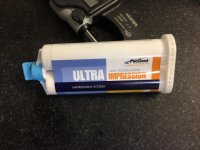gmackugler
Plastic
- Joined
- Jun 9, 2016
I am using flexbar reprorubber casting material (2-part compound injected into part through nozzle) to create impressions of an internal chamfer on a plastic part, for measurement on an optical comparator. I've been experimenting with different flexbar products (thin-pour and medium body), but they are both producing bubbles in the casts and the bubbles are throwing off my measurements.
Does anyone have any tips for avoiding bubbles in the casts?
Thanks
Does anyone have any tips for avoiding bubbles in the casts?
Thanks


